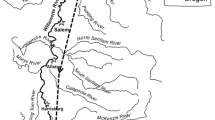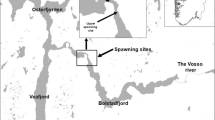Abstract
Historical spawning grounds for sea lampreys (Petromyzon marinus L.) in most Portuguese river basins are becoming inaccessible due to the construction of impassable dams and/or weirs. Studies like the one described in this paper are particularly important in areas like the Vouga river basin, where there is a considerable fishing effort from both professional fishermen and poachers. In fact, for management and conservation purposes, it is important to clarify several aspects of the sea lamprey spawning run in this particular watershed. Therefore, a total of 30 radio tagged, migrating sea lampreys were released in the River Vouga and some of its main tributaries during 2004 and 2005. Results from the tracking sessions were used to determine the effect of poaching on the spawners’ population and the characteristics of the resting sites used during the upstream movement. The rivers’ stretches were also characterized according to the type of substrate present in the riverbed and flow type, in order to determine its aptitude to constitute appropriate spawning habitats for sea lampreys. We have identified in the upstream stretches of River Vouga, and in the tributary River Caima, characteristics that are particularly suitable for the construction of nests by the spawners. Presence of larvae provided evidence that spawners migrated into the River Vouga’s upper reaches. However, abundance and age class diversity appeared to be higher downstream of Sernada and Carvoeiro weirs, corroborating the telemetry data which suggested difficulty in passing these obstacles during low precipitation years. In the River Caima, migration was most predictable, which might be related to daily water releases from a small hydropower dam at dusk, that stimulated the lampreys to resume migration. Poaching has had a considerable negative effect on the success of the tagged lampreys’ migration: 76% of the animals released during 2005 were captured.




Similar content being viewed by others
References
Almeida, P. R., H. T. Silva & B. Quintella, 2000. The migratory behaviour of the sea lamprey Petromyzon marinus L., observed by acoustic telemetry in River Mondego (Portugal). In Moore, A. & I. Russel (eds), Advances in fish telemetry. CEFAS: Lowestoft, Suffolk, 99–108.
Almeida, P. R., H. T. Silva & B. R. Quintella, 2002a. The spawning migration of the sea lamprey (Petromyzon marinus L.), in the River Mondego (Portugal). In Pardal, M. A., J. C. Marques & M. A. Graça (eds), Aquatic ecology of the Mondego river basin. Global importance of local experience. Imprensa da Universidade de Coimbra, Coimbra, 381–386.
Almeida, P. R., B. R. Quintella & N. M. Dias, 2002b. Movement of radio-tagged anadromous sea lamprey during the spawning migration in the River Mondego (Portugal). Hydrobiologia 483: 1–8.
Almeida, P. R., B. R. Quintella, A. Koed & N. O. Andrade, 2005. Using electromyogram telemetry to study the spawning migration of sea lamprey (Petromyzon marinus L.). In Spedicato, M. T., G. Lembo & G. Marmulla (eds), Aquatic Telemetry, advances and applications. FAO-COISPA, Rome, 3–11.
Assis, C. A, 1990. Threats to the survival of anadromous fishes in the River Tagus, Portugal. Journal of Fish Biology 37: 225–226.
Bergstedt, R. A. & J. G. Seelye, 1995. Evidence for lack of homing by sea lampreys. Transactions of the American Fisheries Society 124: 235–239.
Costa, M. J., P. R. Almeida, I. M. Domingos, J. L. Costa, M. J. Correia, M. L. Chaves & C. M. Teixeira, 2001. Present status of the main shads’ populations in Portugal. Bulletin Français de la Pêche et de la Pisciculture 362/363: 1109–1116.
Fine, J. M., L. A. Vrieze & P. W. Sorensen, 2004. Evidence that Petromyzontid lampreys employ a common migratory pheromone that is partially comprised of bile acids. Journal of Chemical Ecology 30: 2091–2110.
Hardisty, M. W. & I. C. Potter, 1971. The general biology of adult lampreys. In Hardisty, M. W. & I. C. Potter (eds), The biology of lampreys, Vol. I. Academic Press, London, 127–206.
Kelso, J. R. M. & W. M. Gardner, 2000. Emigration, upstream movement, and habitat use by sterile and fertile sea lampreys in three Lake Superior tributaries. North American Journal of Fisheries Management 20: 144–153.
Li, W, P. W., Sorensen & D. D. Gallaher, 1995. The olfactory system of migratory adult sea lamprey (Petromyzon marinus) is specifically and acutely sensitive to unique bile acids released by conspecific larvae. The Journal of General Physiology 105: 569–587.
Li, W., A. P. Scott, M. J. Siefkes, H. Yan, Q. Liu, S. Yun & D. A. Gage, 2002. Bile acid secreted by male sea lamprey that acts as a sex pheromone. Science 296: 138–141.
Loureiro, J. & M. E. Macedo, 1986. Bacia hidrográfica do Rio Vouga. In Direcção-Geral dos recursos e aproveitamentos hidráulicos (eds). Monografias hidrológicas dos principais cursos de água de Portugal continental. Divisão de Hidrometria, Lisboa, 207–240.
Morman, R. H., D. W. Cuddy & P. C. Rugen, 1980. Factors influencing the distribution of sea lamprey (Petromyzon marinus) in the Great Lakes. Canadian Journal of Fisheries and Aquatic Sciences 37: 1811–1826.
Quintella, B. R., N. O. Andrade & P. R. Almeida, 2003. Distribution, larval stage duration and growth of the sea lamprey ammocoetes, Petromyzon marinus L., in a highly modified river basin. Ecology of Freshwater Fish 12: 1–8.
Quintella, B. R., N. O. Andrade, A. Koed & P. R. Almeida, 2004. Behavioural patterns of sea lamprey spawning migration during difficult passage areas studied by electromyogram telemetry. Journal of Fish Biology 65: 961–972.
Rogado, L. (coord.), P. Alexandrino, P. R. Almeida, J. Alves, J. Bochechas, R. Cortes, I. Domingos, F. Filipe, J. Madeira & F. Magalhães, 2005. Petromyzon marinus Lampreia-marinha. In Cabral, M.J., J. Almeida, P.R. Almeida, T. Delinger, N. Ferrand de Almeida, M.E. Oliveira, J.M. Palmeirim, A.L. Queiroz, L. Rogado & M. Santos-Reis (eds), Livro vermelho dos Vertebrados de Portugal. Instituto de Conservação da Natureza, Lisboa, 65–66.
Stier, K. & B. Kynard, 1986. Movement of sea-run sea lampreys, Petromyzon marinus, during the spawning migration in the Connecticut river. Fishery Bulletin 84: 749–753.
Sorensen, P. W. & L. A. Vrieze, 2003. The chemical ecology and potential application of the sea lamprey migratory pheromone. Journal of the Great Lakes Research 29: 66–84.
Sorensen, P. W., J. M. Fine, V. Dvornikovs, C. S. Jeffrey, F. Shao, J. Wang, L. A. Vrieze, K. R. Anderson & T. R. Hoye, 2005. Mixture of new sulfated steroids functions as a migratory pheromone in the sea lamprey. Nature Chemical Biology 1: 324–328.
Teeter, J., 1980. Pheromone communication in sea lamprey (Petromyzon marinus): implications for population management. Canadian Journal of Fisheries and Aquatic Sciences 37: 2123–2132.
Vrieze, L. A. & P. W. Sorensen, 2001. Laboratory assessment of the role of a larval pheromone and natural stream odor in spawning stream localization by migratory sea lamprey (Petromyzon marinus). Canadian Journal of Fisheries and Aquatic Sciences 58: 2374–2385.
Young, R. J., K. A. Houston, J. G. Weise & J. R. M. Kelso, 1990. The effect of environmental variables on the population dynamics of sea lamprey, Petromyzon marinus. Canadian Technical Report of Fisheries and Aquatic Sciences 1736, 33 pp.
Acknowledgements
This research was financially supported by two Portuguese Institutions, the Water Institute (INAG) of the Ministry of Environment and by a Ph.D. grant from the Foundation for Science and Technology (FCT) to B.R. Quintella with the following reference SFRH/BD/9125/2002. The authors would also like to thank Gonçalo Tomaz for the useful assistance on the fieldwork.
Author information
Authors and Affiliations
Corresponding author
Electronic supplementary material
Below are the electronic supplementary materials.
Rights and permissions
About this article
Cite this article
Andrade, N.O., Quintella, B.R., Ferreira, J. et al. Sea lamprey (Petromyzon marinus L.) spawning migration in the Vouga river basin (Portugal): poaching impact, preferential resting sites and spawning grounds. Hydrobiologia 582, 121–132 (2007). https://doi.org/10.1007/s10750-006-0540-2
Issue Date:
DOI: https://doi.org/10.1007/s10750-006-0540-2




